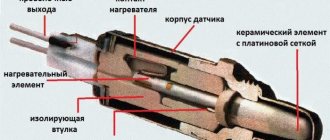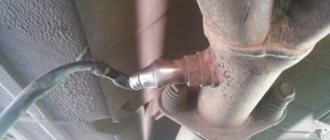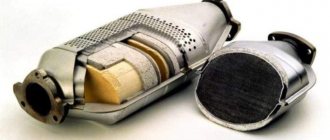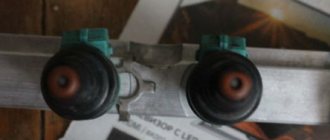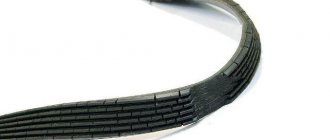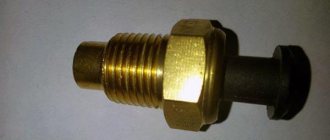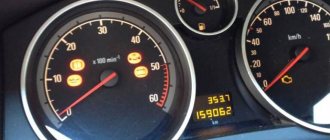Owners of 8–16-valve fuel-injected cars produced in Togliatti often encounter engine malfunctions. At the same time, the Check Engine light often lights up. Among the mass of possible malfunctions, diagnostics often reveal a malfunction of the camshaft position sensor (CPS). Error code P0340 is a common problem on VAZ models. Next, we will tell you why the problem occurs, what signs indicate a DPRV failure, and how to change it.
Principle of operation
The DPRV sensor operates on the Hall principle and is capable of determining the position of the camshaft as accurately as possible at different periods of operation by reading pulses. The device transmits the received information to the electronic control unit (ECU). After this, the main controller adjusts the fuel injection for each injector at a certain time. That is, knowing the position of the camshaft, the on-board computer is able to establish a phased supply of gasoline to the cylinders.
Meter design and location
The operating principle of the DPRV is based on the Hall effect - the sensor reacts to the approach of a metal mass by changing the voltage on the signal wire. The design of the device is similar to another element - the crankshaft position detector. Inside the plastic case there is a coil where the 12 V on-board voltage is constantly supplied.
The meter is installed on the engine cylinder head in close proximity to the camshaft. The latter is equipped with a special plate or gear, whose rotation affects the DPRV. The work algorithm looks like this:
- After turning on the ignition and starting the engine, a supply voltage of 12 V is supplied to the sensor. Through the third signal wire, the element supplies the controller with a voltage of 90–95% of the original one.
- When the protrusion on the rotating part of the camshaft passes next to the DPRV housing, the voltage at the signal contact drops to 0.2–0.4 volts, depending on the design of the device and the vehicle model.
- When the voltage drops, the electronic unit clearly “sees” the valve timing, promptly supplies the fuel mixture to the engine cylinders and directs the spark discharge to the desired spark plug.
Note. On cars with 16-valve engines, 2 sensors are installed - one for each camshaft.
When the meter is faulty, the electronics are unable to control the operation of the gas distribution mechanism. In such cases, the control unit goes into error and is guided by the signals of other meters. Spark generation and fuel supply are adjusted according to the programmed program, which affects the operation of the power unit.
Signs of an error
For balanced engine operation, the ECU collects data from all sensors. If there is no signal from one of them or having received incorrect parameters, the computer warns the driver about this. To do this, he lights up the Check Engine icon on the instrument panel. If there is poor communication with the DPRV, the on-board controller also signals a problem in the system. During diagnostics, the scanner will show error P0340 (quite often on VAZ 2114–2115). Over the long years of using “fours” and “tags”, owners have learned to recognize signs of engine malfunction that are directly related to the camshaft position sensor:
- The engine refuses to start.
- The car starts with great difficulty.
- The engine stalls at idle speed.
- Failures appear and former power is lost.
- Fuel consumption increases.
- The engine starts to stall.
- Check Engine light is on.
If the listed symptoms are not observed, and the diagnostic controller shows error P0340, then most likely a failure occurred in the computer itself. On VAZ 2110, 2111, 2112, 21114, 21124 and other models, Bosch M7.9.7 and January 7.2 ECUs were installed. They may become buggy after free firmware updates.
How to get rid of error p0340
Methods for getting rid of malfunctions that caused the formation of error p0340 (malfunction in the camshaft position sensor circuit) depend on the causes of their occurrence, as well as the specific car model - for example, Nissan, Ford, Chevrolet, Opel, Toyota. , VAZ (in particular, VAZ 2114). However, the general verification algorithm will be as follows:
- Using an error scanner, check the ECU memory for errors p0340 and possible others. If only one error is detected (or related ones, for example, p0342, p0343), then you should try to reset, as indicated above. That is, remove them using software or by disconnecting the negative terminal of the battery for 10...20 seconds. If the error disappears after starting the engine, it means that it was a false response of the sensor or ECU. If the error occurs again (you should read the error number again with the scanner), then you need to continue further diagnostics and repairs.
- Check the latch, which ensures rigid contact between the chip and the sensor body. In some situations, it can be broken off, and this leads to loss of contact between all or individual wires and contacts on the sensor.
- Check the quality of installation of the sensor in its mounting location. In particular, check the tightening torque of the nut (usually the sensor is secured using a bolt with a nut with a diameter of 10 mm or similar, depending on the specific engine). Make sure that the engine has the correct sensor for this particular motor. In particular, not only in terms of fastening, but also in model, since sensors may differ in both geometric shape and size, and because of this, the sensitive element of the sensor will not detect the passage of a rapper near it, which will lead to the absence of corresponding signals on the ECU. If the sensor is not suitable, you need to buy a new camshaft sensor and replace it.
- Visually check the condition of the contacts and terminals in the electrical circuit for connecting the camshaft sensor. In some cases, oxidation (rust) occurs on critical terminals, which leads to a decrease in the quality of contact. This is due to exposure to moisture and/or simply old age. If oxides are detected, you must get rid of them by thoroughly wiping the contacts. To clean difficult stains, you can use special electrical contact cleaners.
- Using a multimeter in continuity mode or measuring insulation resistance, you need to verify the integrity of the wires coming from the computer to the camshaft sensor.
Usually there are three wires. In addition to checking the integrity of the wires, it is also necessary to check the insulation resistance value in pairs between them, as well as between each of the wires and the machine body (“ground”). However, in the latter case, the ground wire will “ring” with the body. Moreover, in the process of the described test, the multimeter probes must be placed on the contacts of the corresponding connectors. Scheme for checking the PRV sensor - When checking the insulation resistance value, you need to clearly know which connector on the “chip” is responsible for what. For example, on the already mentioned VAZ-2114 (and on other front-wheel drive VAZs) two types of camshaft sensors are used - 21110-3706040 and 21120-3706040. They differ in contacts. The first sensor has contact “A” - ground, “B” - signal wire, “C” - power (plus). The second sensor has contact “A” - ground, “B” - power, “C” - signal wire. Usually the second end of the power wire (plus) comes from the control relay. As for similar sensors on other machines, you must additionally look at their documentation (sensor connection diagrams).
- If checking the wires shows that they have defects (breakage, damage to insulation), then it is necessary to perform a visual inspection of them in order to determine the location of their damage. First of all, you need to pay attention to the places of bends and fractures, where the wires change their shape and can simply fray as a result of vibration. You also need to inspect whether the wires pass through places where moisture or process fluids (for example, lubricant) accumulate. Over time, the insulation in these areas may become compromised. If the location of the damage cannot be found, it means that the entire wiring of the camshaft position sensor needs to be replaced. In this case, it is necessary to use special flexible automotive wires with the appropriate core cross-section.
- If everything is fine with the wires and the chip, then you should check the condition of the sensor itself. You can read how to do this at the link above. If the situation allows, you can replace the sensor with a known working one. Please note that there are many sensors on the market today that are of frankly poor quality. Accordingly, it is better to choose original sensors in accordance with the documentation for the car, and order them from official representatives of the automaker. This is expensive, but can pay for itself, since low-quality sensors will have to be purchased again and time and effort spent on installing them.
- If there are no problems with the camshaft sensor, you need to check the normal operation of the electronic control unit. However, it is not recommended to do this yourself, since this is a complex and important part of the car. Therefore, for help, you need to contact a car service center, where there are specialists and additional diagnostic equipment.
Finally, it is worth noting that when identifying malfunctions of the camshaft sensor, it makes sense to check the operation of the crankshaft sensor, since these shafts work synchronously, and if there is no signal from the camshaft sensor, then the ECU uses signals from the crankshaft sensor. It is necessary to check if there are any errors in the memory of the electronic engine control unit regarding the DPKV, for example P0335, and also, if possible, inspect its mechanical condition and wiring (similar to the DPKV).
Conclusion
Error p0340 is not a critical error, and if it is formed in the memory of the electronic engine control system, the car can be used. However, this leads to loss of engine power, “floating” idle speed, and increased fuel consumption. This is especially true for cars equipped with gas equipment and using gas as fuel.
Therefore, it is better not to drive for a long time with such an error, as it will cause a lot of inconvenience to the driver. Accordingly, it is advisable to carry out diagnostics and carry out repair work as early as possible, especially since they are simple and most car enthusiasts can handle them.
Reasons for failure
Quite often, the cause of error P0340 on VAZ models is the sensor itself (DPRV). Over time, its internal contacts are destroyed. But sometimes a failure occurs due to other reasons, such as:
- Wear of camshaft pulleys (appearance of backlash).
- The timing belt jumped 1-2 teeth.
- The wires on the power supply have oxidized.
- Broken wire or short circuit.
- The plug came loose randomly.
Very often error P0340 appears on VAZ Kalina models. The car simply refuses to drive without changing the throttle. Here, the fault is often the controller itself, located under the heating radiator, where it is simply filled with coolant (antifreeze, antifreeze) when depressurized. The experts already know: if the “brains” are washed and dried, the fault disappears and Kalina will drive again.
Re: 2114 high signal level of the phase sensor
A high level is, as you were correctly told, a cliff. When the sensor is disabled, the level will be “High”. The sensor is checked very easily: remove the connector from the sensor, find 1 contact of the connector (wire white/black) - this is ground (GND), on the next contact (pink/black) - +12V (sensor power supply, this is constant power from the output of the main relay ), on pin 3 (pink wire, I think) when the sensor is disconnected there should be 11.8-12.2 V, this is the signal power supply from the ECU. If all these voltages are present, then we proceed to checking the phase sensor itself: pull out the sensor, connect it to the connector, use a tester to test the negative probe on 1 contact, the positive probe on 3 contact. The voltage should be 11.8-12.2V, now bring a knife, screwdriver or flat metal plate to the end of the sensor (where type 13K is written) - the voltage should drop to 0V, removing the plate the voltage will rise to 11.8-12.2 volts. If all these conditions are met, the sensor is operational.
On which engines does p0340 pop up more often?
According to the observations of service workshop specialists, failure of the air flow control valve occurs more often on 16-valve engines. But engines with 8 valves also suffer from error P0340, especially after installing gas equipment (LPG). Moreover, the malfunction is repeated regularly, so the technicians have to adjust the gas equipment to the optimal fuel supply mode again and again. As a result, such cars have chronic problems with engine starting and loss of power.
Recommended Tools to Troubleshoot P0340
- Reading error codes and engine parameters - LAUNCH X431.
- Car charger - this or similar.
- To measure wiring use a digital multimeter.
- Electrical contact cleaner.
- Advanced diagnostics - oscilloscope.
Previous post Error P0562 - what it means, symptoms, causes, diagnosis, solution
Next entry Error P0137 - what it means, symptoms, causes, diagnosis, solution
Replacing the DPRV
If there is no wire break, and the power supply is not in place, then most likely the problem is in the DPRV itself. It needs to be changed. To work, you will need a 10 mm socket wrench (head). The sensor is located in a visible place, on the right side of the head. Attached with only 2 bolts. But despite the close and convenient location, getting to the distant bolt is very inconvenient. There have been cases in practice when owners removed the intake manifold and the ramp with injectors. Other owners simply broke the sensor housing and then removed the bolt. In general, the process of replacing the DPRV looks like this:
- Disconnect the negative terminal from the battery.
- Disconnect the DPRV plug.
- Unscrew the 2 sensor mounting bolts.
- Install a new DPRV.
- Connect the power plug.
- Place the negative terminal on the battery.
There is no need to start the car right away. First, turn the ignition on and off 2-3 times. Let the ECU see the working sensor. Then you can start the car and check the quality of the engine. If the Check Engine icon is still on, you need to connect the controller and erase error P0340.
Re: 2114 high signal level of the phase sensor
I couldn't find a topic for my question, so I'll ask it here. The essence of the question: VAZ 2115 error: low signal level from the phase sensor. The client has already changed 3 sensors. This car came to me with a request to turn off the 2nd DC (leave the 1st DC partially). I did my job, but the client came with a complaint “the check light is on”, I connect the scanner and take a look. I say that there is an error in the phase sensor, but he tells me that he has already changed 4 sensors, but the result is the same. The sensor that was on his car was really “dead”, the voltage at the output “C” of the connector was really 0V. He replaced the sensor with another (which he was told was faulty) - the voltage rose to the required 11.8 V, installed it on the machine, the oscilloscope showed the pulses, even, with the marks in place. Released the client. Yesterday he arrived - the check light is on again, the error is again low signal level from the phase sensor. I connect, look, it’s really 0v. I disconnect the sensor (on the connector) 11.8 V, connect it to 11.8. I start the car - it works, the pulses go. (!) BUT the pulses go until you turn off the ignition and the main relay turns off, after which 0.43 V hangs at terminal “C” for some time, and then the voltage rises to 1, 35c. After this, turning on the ignition, the sensor displays 0.38V, which does not rise when starting. If you disconnect and connect the sensor connector, the voltage is restored to 11.8 and the sensor starts working. Again until the ignition is turned off. That's the problem. Today the client will bring another phase sensor, I'll try it. But for some reason I’m sinning on the ECU (it has a Bosch M7.3). If all else fails, I'll reflash it without a phase sensor. Has anyone encountered this problem?
DPRV error. The key assembly on the crankshaft is broken
This also applies to synchronization problems. When the key assembly on the crankshaft breaks, then play appears there and this leads to a mismatch between the DPKV and DPRV signals. This also leads to the appearance of an error due to an incorrect DPRV signal.
Therefore, it is necessary to remove the drive belt pulley and behind it you can see the timing belt pulley
We hang the wheel, engage the gear and turn the wheel back and forth. If the key is broken, then you will definitely see play between the pulley and the crankshaft.
This problem is quite dangerous. The key is cast on the pulley itself and if the key wears out, it is necessary to urgently replace the pulley itself before the seat on the crankshaft breaks.
Therefore, when tightening the pulley bolt, it is necessary to observe the strictly prescribed tightening torque and mark the bolt with paint so that if it is unscrewed, you will quickly notice it. How to do this is shown in the link above about replacing the timing belt.
CMP Camshaft Position Sensor Error Codes
| Common CMP Trouble Codes | Cause of camshaft sensor error |
| P0340 CMP | No signal from camshaft sensor |
| P0341 CMP | Incorrect valve timing |
| P0342 CMP | Camshaft sensor circuit low |
| P0343 CMP | Camshaft sensor circuit high |
| p0344 CMP | Unstable signal from the camshaft sensor (intermittent signal) |
What was the problem?
And the problem was in the timing marks. How to check timing marks is available on the Internet. There are a lot of articles and videos. In some incomprehensible way, my timing belt jumped by 2 teeth and because of this, errors began to appear. I had to go and set the marks again.
Updated August 7, 2022.
It's been exactly a month since my timing marks were adjusted. The error never appeared again. I hope this post helps you.
In general, with the VAZ I realized one thing - you don’t need to run and change the sensors first, as I often did, you first need to figure out what the reason is. In my case, errors P0340 and P0335 were a consequence of replacing the timing belt, although for some reason I didn’t think about it.
Source
DPRV error. Incorrect sensor installation
The sensor has some play in its seat. Therefore, it can be tilted slightly to the right or left. Since the sensor only works with the right camshaft (exhaust), most often it must be tilted to the right for normal operation.
But there are times when it is necessary to deviate to the left. This depends on the sensor used.
Therefore, if you have already tried all the options for dealing with the DPRV error, then move the sensor and observe.
What is the sensor for?
Using the phase sensor on the Kalina, it is possible to determine the engine operating cycle and generate a certain signal. This device is an integral element, in other words, it contains a sensing component and a signal converter. The working part of the sensor operates on the Hall effect. It responds to changes in the magnetic field. The secondary circuit contains a bridge circuit, as well as a special operational amplifier and a transistor stage. And the latter is carried out according to an open collector circuit.
Using a phase sensor (VAZ-2114 or on any other model), the moment of fuel injection is selected only into the first cylinder, and based on this, into all the others. The camshaft makes it possible to determine which valve is in the open position and which phase of operation is taking place. If the sensor malfunctions, an error light appears on the on-board computer, and engine operation goes into emergency mode. Work is carried out only according to the signal that comes from the crankshaft position sensor.
Finding the cause of error P0340
Using a diagnostic scanner, you need to make sure that there is an error. After this, you can begin to search for the culprit of its appearance:
- Check the DPRV wiring (between the connector and the sensor) for damage, short circuit or corrosion.
- Check the sensor connector for mechanical damage or corrosion.
- Check the wiring from the connector to the ECU for damage, short circuit or corrosion.
- Eliminate the causes of other errors that are stored in the ECU memory, which may be related to the operation of the DPRV.
- Use a scanner or oscilloscope to check the voltage of the DPRV for compliance with performance indicators (individually for each car).
- If the DPRV voltage readings are incorrect, the sensor must be replaced.
- If the voltage reading is within the normal range, the engine control module may be faulty. It may need to be replaced or reprogrammed.
Common mistakes when diagnosing P0340
Before replacing the DPRV, it is very important to carefully check the wiring and connectors of the sensor to eliminate these causes of malfunction. Very often this is not done, and replacing the sensor does not help solve the problem.
Another common mistake is that the diagnostician does not take into account the problem with the presence of misfires or a malfunction of the crankshaft position sensor (CPS). These factors can cause the P0340 code to appear.
Features of phased injection
The phase sensor on the Kalina and Priora engines is located in the upper part. It's next to the air filter housing. The operation of phased injection is characterized by the following features: an impulse is sent from the phase sensor to the electronic engine control system. The latter controls the fuel supply, as a result of which the injector opens and the fuel-air mixture enters the combustion chamber immediately before the intake valve begins to open. As soon as the valve opens, air is sucked in and the fuel mixture enters the combustion chamber.
Trouble
I’m driving home, at about the 60th kilometer I get error P0340 - camshaft position sensor error. The check light did not light up, I saw the error on the on-board computer (state).
I came home and reset the error. The next day I go to work and there are no errors. Well, probably a stray mistake. It happens to everyone.
A day later I was driving around the city and heard a squeak from the on-board vehicle and the inscription: there are errors in the ECM system. Crap.
The check did not light up again; this did not affect the driving performance of the car. I come to work, look at the error - P0340 again. Soooo, now it's more interesting.
I drove like this for another day, but I couldn’t reset the error. As soon as you start the car, P0340 appears. You reset it, turn it off, start it again - and again the error occurs. I decided not to reset the error and try to start the car with this error. The car took a very long time to start! The starter spun for about 3-4 seconds, instead of the standard 1 second.
At this moment, error P0335 appeared in addition to error P0340. As they say, trouble does not come alone. Then I did not yet know that in my case they were interconnected.
I decided to change the camshaft sensor. The new one cost about 500 rubles, the most interesting thing is that it was exactly the same as the old one.
And of course it didn't help. The error came out again.
Diagnosis and problem solving
First of all, you need to read all stored error codes using an OBD-II scanner. If there are no other faults, proceed to solving the problem.
It is necessary to check the wires, connectors and other electrical components of the system. If any defects are found, eliminate them. After this, you need to clear the error codes from the PCM memory again and recheck the system.
If the error code appears again, check the battery charge and also inspect the starter motor. Troubleshoot, then clear the PCM memory again and check the system to see if P0342 appears again.
This procedure must be performed every time after repair work is performed. This will help determine if the problem is resolved.
Check the camshaft sensor itself if you need to replace it. In most cases, these steps will help fix your vehicle's problem.
